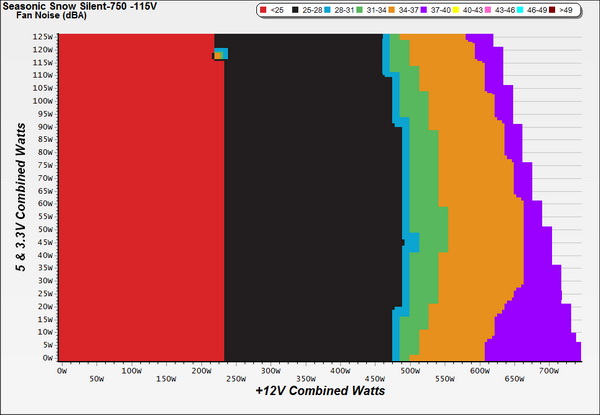Seasonic Snow Silent 750W Power Supply Review
Recently, Seasonic introduced a new 750W Snow Silent unit, featuring Platinum-rated efficiency, fully modular cabling and semi-passive operation.
Why you can trust Tom's Hardware
Efficiency, Temperature And Noise
Efficiency
Our efficiency testing procedure is detailed here.
Using the results from the previous page, we plotted a chart showing the efficiency of the Snow Silent 750 at low loads, and loads from 10 to 110 percent of the PSU's maximum-rated capacity.
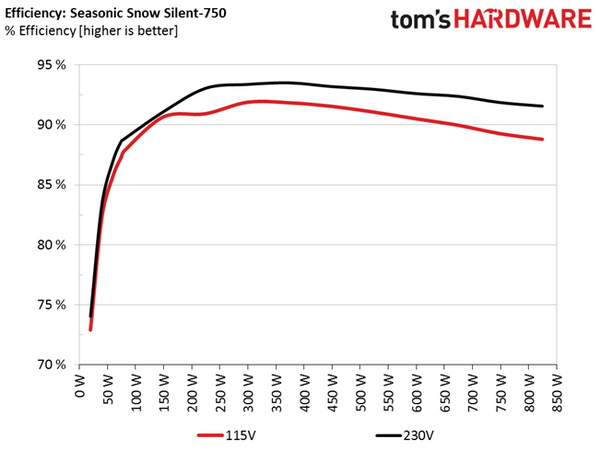

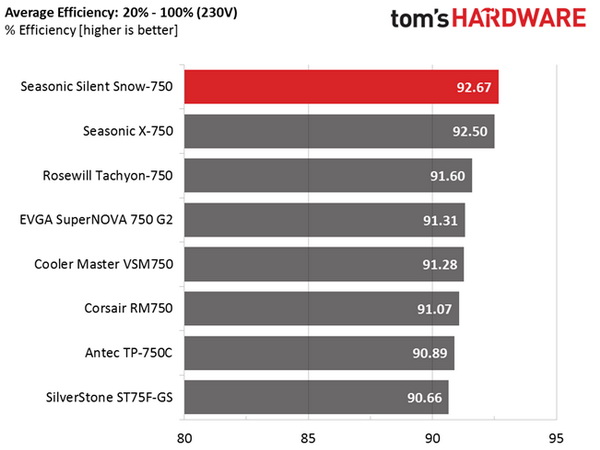
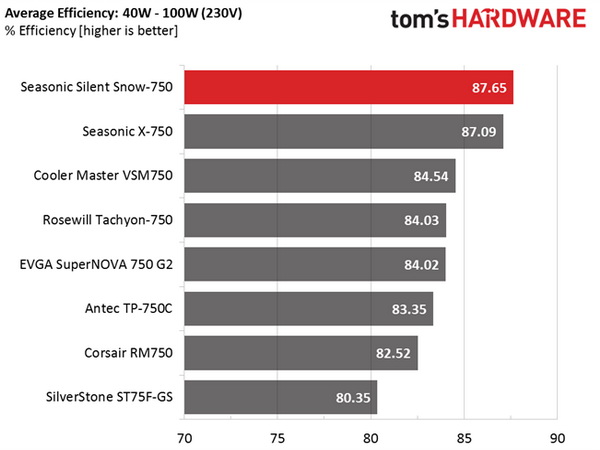
With 230VAC input, this is among the most efficient 750W PSUs we have ever tested. The same applies to light-load tests. Seasonic's improved XP2S platform can be considered among the best money can buy today in this medium-capacity category.
Efficiency At Low Loads
In the following tests, we measure the efficiency of the Snow Silent 750 at loads significantly lower than 10 percent of the device's maximum capacity (the lowest load the 80 PLUS standard measures). The loads we dialed were 20, 40, 60 and 80W. This is important for representing when a PC is idle, with power-saving features turned on.
| Test # | 12V | 5V | 3.3V | 5VSB | Power(DC/AC) | Efficiency | Fan Speed | Fan Noise | PF/AC Volts |
|---|---|---|---|---|---|---|---|---|---|
| 1 | 1.197A | 0.491A | 0.476A | 0.191A | 19.58W | 72.90% | 0 RPM | 0 dB(A) | 0.832 |
| 12.145V | 5.034V | 3.348V | 5.131V | 26.86W | 115.0V | ||||
| 2 | 2.426A | 0.989A | 0.985A | 0.390A | 39.74W | 82.28% | 0 RPM | 0 dB(A) | 0.927 |
| 12.145V | 5.034V | 3.348V | 5.124V | 48.30W | 114.9V | ||||
| 3 | 3.658A | 1.478A | 1.491A | 0.584A | 59.84W | 85.76% | 0 RPM | 0 dB(A) | 0.959 |
| 12.144V | 5.033V | 3.347V | 5.118V | 69.78W | 114.9V | ||||
| 4 | 4.873A | 1.983A | 1.970A | 0.780A | 79.74W | 87.83% | 0 RPM | 0 dB(A) | 0.970 |
| 12.144V | 5.034V | 3.347V | 5.111V | 90.79W | 115.0V |
The PSU's efficiency under light loads is superb in three out of the four load tests we conducted, easily surpassing the 80 percent mark. In addition, the fan didn't spin at all during these tests, allowing the unit to achieve zero noise output.
5VSB Efficiency
The ATX specification states that 5VSB standby supply efficiency should be as high as possible, recommending 50 percent or higher efficiency with 100mA of load, 60 percent or higher with 250mA of load and 70 percent or higher with 1A or more of load.
We will take four measurements: one each at 100, 250 and 1000mA, and one with the full load the 5VSB rail can handle.
Get Tom's Hardware's best news and in-depth reviews, straight to your inbox.
| Test # | 5VSB | Power (DC/AC) | Efficiency | PF/AC Volts |
|---|---|---|---|---|
| 1 | 0.102A | 0.52W | 73.24% | 0.095 |
| 5.136V | 0.71W | 115.5V | ||
| 2 | 0.252A | 1.29W | 76.79% | 0.197 |
| 5.131V | 1.68W | 115.5V | ||
| 3 | 1.002A | 5.13W | 78.68% | 0.394 |
| 5.116V | 6.52W | 115.5V | ||
| 4 | 3.002A | 15.23W | 80.58% | 0.490 |
| 5.073V | 18.90W | 114.9V |
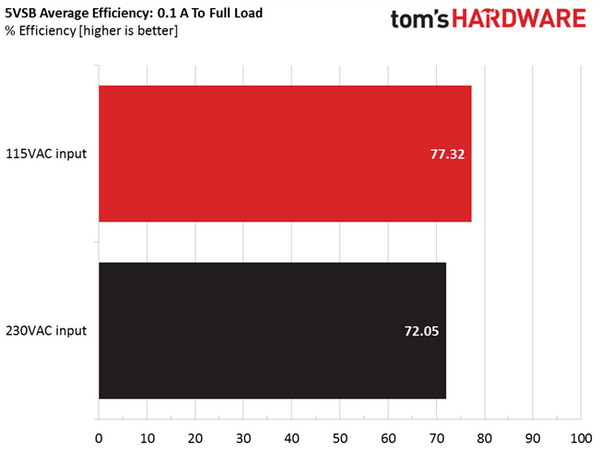
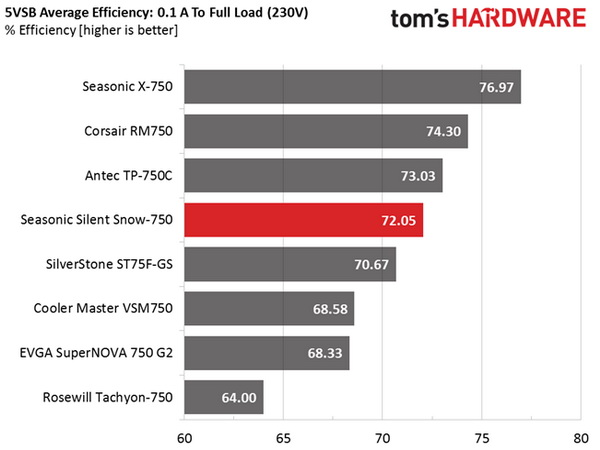
Efficiency performance on the 5VSB rail was average. This surprised us, since the older Seasonic X-750 managed to significantly outperform the higher-grade Snow Silent unit.
Power Consumption In Idle And Standby
| Mode | 12 V | 5 V | 3.3 V | 5VSB | Power (AC) | PF/AC Volts |
|---|---|---|---|---|---|---|
| Idle | 12.143V | 5.034V | 3.349V | 5.138V | 6.03W | 0.458 |
| 115.1V | ||||||
| Standby | 0.11W | 0.016 | ||||
| 115.3V |

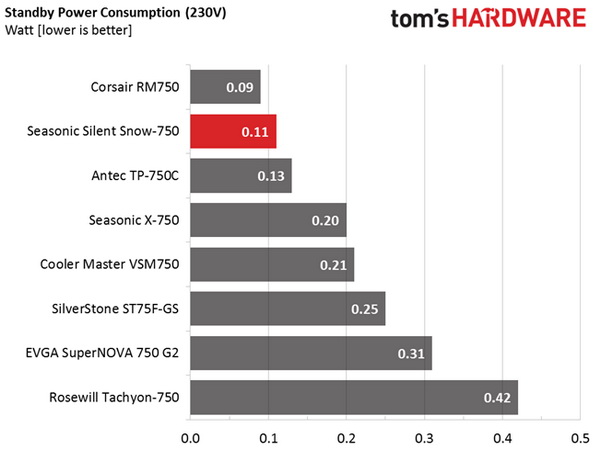
In the table above, you'll find the power consumption and voltage values of all rails (except minus 12V) when the PSU is idle (powered on, but without any load on its rails), and the power consumption when the PSU is in standby mode (without any load, at 5VSB).
Vampire power is low with 115VAC input and a tad higher with 230VAC, as usual. Overall, this unit has minimal energy demands in standby mode, which is good news for the environment as well as your wallet (especially in the long run).
Fan RPM, Delta Temperature And Output Noise
Our mixed noise testing is described in detail here.
The first chart below illustrates the cooling fan's speed (RPMs), and the delta between input and output temperature. The results were obtained at 36 °C (96.8 °F) to 45 °C (113 °F) ambient temperature.
The next chart shows the cooling fan's speed (RPMs) and output noise. We measured acoustics from one meter away, inside a small, custom-made anechoic chamber with internals completely covered in soundproofing material (be quiet! Noise Absorber kit). Background noise inside the anechoic chamber was below 18 dB(A) during testing, and the results were obtained with the PSU operating at 36 °C (96.8 °F) to 45 °C (113 °F) ambient temperature.
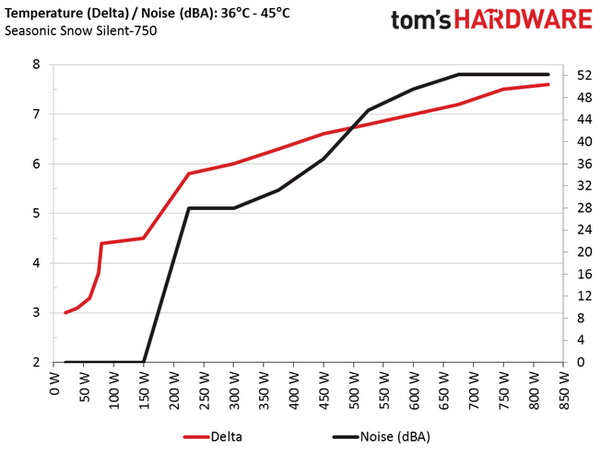
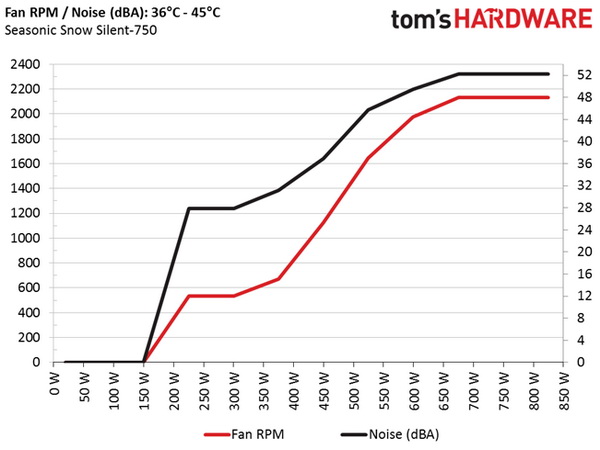
The following graph illustrates the fan's output noise over the entire operating range of the PSU. The same conditions of the above graph apply to our measurements, though the ambient temperature was between at 28 °C (82.4 °F) to 30 °C (86 °F).
The Snow Silent unit honors the second part of its name, providing quiet operation throughout most of its operating range. The combination of a medium-speed FDB fan, semi-passive operation and the relaxed fan profile play a key role in this unit's decreased noise output. It's definitely a PSU that will please users who are sensitive to noise.
Current page: Efficiency, Temperature And Noise
Prev Page Load Regulation, Hold-Up Time And Inrush Current Next Page Cross-Load Tests And Infrared Images
Aris Mpitziopoulos is a contributing editor at Tom's Hardware, covering PSUs.
-
dragget "Unfortunately, the on/off switch for toggling hybrid mode is located on the back side of the PSU, so accessing your system's internals becomes necessary if you want to change fan modes."Reply
Most likely they did it this way to avoid having two switches on the outside face of the PSU. If they had placed both switches there I can see people reaching around the back of their case to change fan modes and accidentally turning off their PC because they flipped the wrong switch. -
Adroid Yea to be honest I prefer the fan/hybrid toggle on the INSIDE of my case anyway. I put my Seasonic Platinum 650W in hybrid mode a long time ago and forgot about it.Reply
I don't see any need to flip the switch on and off, in fact I can't think of a single good reason why I would ever want to touch the thing again. So for me, it would be a con to have the switch on the outside of the case. -
Aris_Mp this switch is much smaller than the on/off one so it is really hard to mix them up. Also the on/off switch is harder to activate. In any case as a reviewer I see this as a con, not a serious though. Some users out there will share my opinion while others won't.Reply -
dragget Replythis switch is much smaller than the on/off one so it is really hard to mix them up.
If you were looking at the back of the PSU, then yes, but I'm assuming the more common situation where the user is reaching around the back of the case where they can't see. In this scenario, one would have to feel around the back with their hand so it's much easier to get it wrong. I almost never use the switch on the back of my PSU, so every two or three months when I DO use it, I have to fumble around in the back to find the switch. For your average user, having two switches back there would just be asking for trouble.
-
MasterDell A lot of companies are putting the hybrid switch on the inside of the PSU. Just like the new units EVGA is putting out. It makes no sense to put the switch on the outside due to confusion with the on/off switchReply -
dstarr3 Reply180 dollars for this? No.
For a rock-solid PSU with a 7-year warranty? This thing would power my next three or four computers. $180 for not having to buy another PSU for a decade is a damn good deal.
Regarding the fan switch, my PSU has a similar feature, and honestly, I imagine most people would set it at installation and never change it. I sure haven't. -
Aris_Mp Indeed a PSU is an investment, something that unfortunately most people cannot see or understand while on the same time they have no problem spending serious money on GPUs and CPUs.Reply
You can keep a good PSU for many system builds while a not reliable, cheap PSU besides breaking down fast can also destroy many of your system components.
